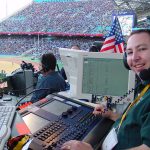Fred Flintstone was a member of the Loyal Order of Water Buffaloes Lodge #26 and was continually trying to gain leader status of this group by becoming the "Grand Poobah." This high-ranking position would have allowed him to rule over all others and reign supreme over the group's members. Much in the same manner, the Grand Master on your lighting console rules over all other masters and has supreme control over the intensities of your fixtures. Believe it or not, this slider and its associated DBO (Dead Black Out) button can be extremely useful during the programming and playback of automated lighting.
How it Works
The Grand Master behaves in the same manner on most lighting consoles (but always consult your manual to understand how it operates on your console). Generally, the grand master adjusts the highest possible intensity for all fixtures. When the grand master is at 100 percent then all fixtures can achieve 100 percent intensity if programmed to do so. However if the grand master is at 50 percent then all programmed intensities will be half of their programmed values. For instance, a programmed value of 80 percent will become 40 percent when the grand master is at half.
The grand master has great control over intensities coming from most elements of the lighting console. This means that it not only takes affect on other playbacks, but also on data in your programmer or editor. In addition, the grand master will not affect values that are parked, nor will it affect RGB LED fixtures (unless it has a virtual intensity value). Remember also that the grand master only limits intensity values at the output; none of your data is actually changed.
Most consoles also have a DBO button associated with the grand master. This button may be momentary or it may lock on. When activated, it will instantly bring all intensities to zero until it is released or activated again. Most consoles have LED or on-screen level indicators for the Grand Master and the DBO state. Usually the LEDs will flash if the grand master is not at 100 percent, because in most circumstances, you want it at 100 percent nearly all of the time.
The Biggest Mistake
At some point in everyone's lighting career, they will find themselves sitting at a lighting console not able to figure out why there is no output from the desk. You will troubleshoot for minutes or hours trying to determine why nothing is coming up. Eventually you look across your desk and realize the grand master is at zero. Don't worry, this happens to everyone at least once! (Guilty! -ed.)
The grand master can be very useful to ensure that the lights are not used by others who do not understand the console. For example, if you need to walk away from the desk for a period of time, you might leave the grand master at zero so that others who get button happy do not end up turning on fixtures. When you return however, you must remember the level of the grand master; otherwise you will become confused by no console output.
A Very Special Fader
What makes the grand master so special? At anytime I can reach over and completely dim out all the intensities of my lights. I have been on productions where the director was asking about a light spill and I could quickly bring down the grand master to prove it was not coming from my desk. Or I can use the grand master to lower the output to provide better lighting for a television camera. I also have brought down the grand master when the LD wanted to see only the followspots, or the rehearsal had ended.
The point is that the quick ease of blacking out or dimming down at any given moment provides extreme power without having to determine what to dim. If during a rehearsal a band stops playing mid-song and the lights are strobing in their eyes, I can quickly dim this look without losing my place in the playback. Then when they are ready to continue, I can bring the grand master back up and continue.
Let's Go Live
In a live show, when playing back on-the-fly (busking, winging it, or punting), I find using the grand master and DBO button very helpful. I will often ride the grand master fader up and down with the beat of the song or flash the DBO key accordingly. By doing so, I can flash or pulse the entire rig without having to create a special button to do so. However, I must be conscious of the fact that the grand master controls all intensities on the desk. So this means that any media servers, smoke machines, non-dims, etc., will also be turning on and off. In some cases, use of the grand master may not be desirable simply because it does control all fixtures in the desk.
I was once programming a show for an LD and during a performance he began flashing the DBO to the beat. Suddenly he looked at me and yelled for help because he had managed to mash the button into the desk, locking it in permanent blackout! I had to quickly decide if I was going to switch to the backup console or see if I could pry the button loose. Luckily there were followspots illuminating the band and I was able to pry the button loose within a few seconds, like MacGyver, with my Swiss Army knife.
A Custom Grand Master
Some consoles let you define fixtures affected by the grand master. In the patch configuration screen there will be a toggle to determine if the grand master has any affect on the intensity of each fixture. In addition, many consoles have "inhibitive submasters," which is a special type of master that behaves just like a grand master, but only for the fixtures you store within it. For instance, you can store only your floor fixtures in a specific inhibitive submaster. Now, when this fader is at 100 percent, your floor fixtures will have the ability to go to 100 percent. But if this fader is lowered, then so is the relative intensity of all the fixtures stored in the fader.
Inhibitive submasters are extremely useful as they allow you to define the exact control of the master. Some consoles even allow you to create inhibitive submasters based on specific conditions, such as a position palette/preset. In this case, you can have a master that only affects fixtures that are currently in the "Singer" position. This is invaluable when your artist says the lights are too bright in his eyes.
Vote for Fred!
Fred Flintstone wanted to be the Grand Poobah so he could exercise control over all his subjects, and your console gives you this ability with the slide of a fader. Feel free to use it as you will, but do not forget the power within. When used improperly, it can cause you heartache or worry, but most of the time you will find it very useful. Lighting control manufacturers make this feature available on almost all consoles, and with proper understanding, you too can get the most out of its power and become the Grand Poobah of your console.



